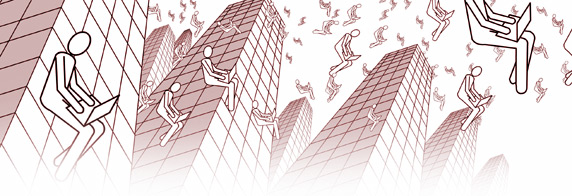: : : : : : : I’m walking through a park and notice a man at a picnic table, rapidly typing on his laptop. I approach him with the question, “is there Wi-Fi in this park?” “There sure is,” he replies. “Just connect to the network named ‘default’ and you’re on.” I sit across from him and open my laptop, and, while my computer starts up and connects to the Internet for free via radio waves, we converse about what we’re working on. As it turns out, we are both freelancers using the park as a sort of extended office space. This scene is becoming more and more familiar, as the widespread availability of Wi-Fi networks in nearly all major cities spawns a level of Internet use in public that is unprecedented. People are sitting in cafés, parks, and public squares, reading weblogs and e-mailing documents to their colleagues. These nomadic Wi-Fi users are able to feel part of one community (the usual crowd at the local park) at the same time as they feel part of another (instant messaging with colleagues at work). Wi-Fi users move from hotspot to hotspot, engaging in their online business as well as enjoying unexpected encounters like my conversation in the park. In the increasingly competitive job market, being accessible at all times has become a requirement for many. While being connected by cellphone has assisted freelancers and salaried employees alike in maintaining business communication, it is often equally important to access documents for review or follow-up with several colleagues or clients at once over e-mail. The emergence of Wi-Fi networks in urban space has enabled savvy members of the workforce to keep tabs on what’s going on at the office without sacrificing their connections to urban culture. One such community group is Île Sans Fil (French for ”Wireless Island”), a group based in Montreal, Quebec. Île Sans Fil (or ISF for short) is composed of dedicated volunteers that install and maintain Wi-Fi access points all over the island of Montreal. ISF has a vision far beyond simply providing free Wi-Fi access, however. “Unlike for-profit providers, ISF encourages the development of independent and local media for each of its hotspots,” says Michael Lenczner, one of the group’s founders. ISF has projects in the works that will change their captive portal page from a simple registration and login form to a content-rich website, linking users to each other, and displaying location-specific art and culture content to users. Montrealers are currently enjoying access to Île Sans Fil’s growing list of hotspots, but where does that leave Torontonians? Unfor-tunately, it seems that there is no active group developing and maintaining free Wi-Fi hotspots in Toronto. For now, there seem to be many Wi-Fi networks that businesses and homeowners have left open on purpose. But without a grassroots group to keep the emphasis on consistently providing free and open access, these generosities can evaporate at a moment's notice. If a grassroots group doesn't step in, it won't take long before the corporate, pay-per-use networks take over. Corporate developers are signing up hotels, airports, and entire restaurant franchises to use their networks, which will charge users anywhere from five to fifteen dollars for a day of Wi-Fi access. These fee-based networks are turning up everywhere, and are an ugly antithesis to the benevolent efforts of groups like Île Sans Fil. The strategies we use to defend public space should extend not just to the ground we walk on but also to the signals carried in the air around us. The value of adding Wi-Fi hotspots to public spaces “all depends on who is controlling them,” says Lenczner. Wireless community groups are working to defend open access and activate latent potential for new kinds of public interaction. While this struggle ensues, my colleague in the park and I will move on to the next hotspot, seeking out more ways to integrate our physical and virtual realities. |
WI-What? |
spacing.ca || contact || subscribe || in this issue || stores (c) 2005 Spacing Publishing |

